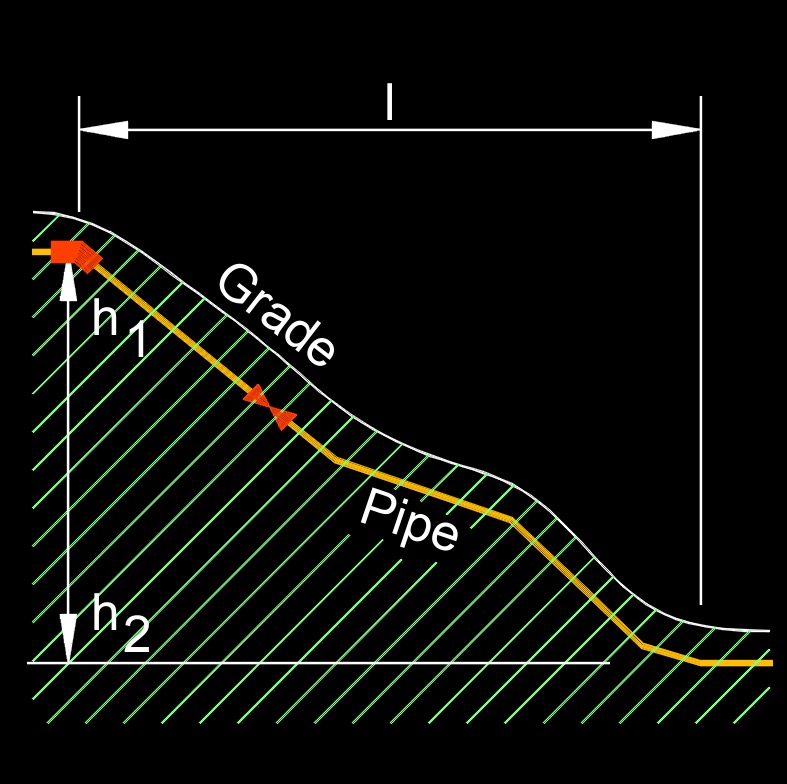Darcy-Weisbach Equation
Darcy-Weisbach Formula |
||
| \( h_l \;=\; f \cdot \dfrac{ l }{ d } \cdot \dfrac{ v^2 }{ 2 \cdot g } \) (Darcy-Weisbach Equation) | ||
| Symbol | English | Metric |
| \( h_l \) = Head Loss | \( ft \) | \( m \) |
| \( f \) = Friction Factor | \( dimensionless \) | \( dimensionless \) |
| \( l \) = Pipe Length | \( ft \) | \( m \) |
| \( v \) = Fluid Velocity | \(ft \;/\; sec\) | \(m \;/\; s\) |
| \( d \) = Pipe Inside Diameter | \( in \) | \( mm \) |
| \( g \) = Gravitational Acceleration | \(ft \;/\; sec^2\) | \(m \;/\; s^2\) |
 The Darcy-Weisbach equation, abbreviated as DW, is the most common way of expressing the pressure drop of a piped fluid. The equation is valid for fully developed, steady state and incompressible flow. The Darcy-Weisbach equation with the Moody Diagram are considered to be the most accurate model for estimating frictional head loss in steady pipe flow. It's an empirical equation used in fluid dynamics and hydraulic engineering to calculate the pressure drop or head loss in a pipe or channel due to fluid flow. It relates the head loss to various factors such as flow rate, pipe characteristics, and fluid properties. This equation accounts for the frictional losses that occur as the fluid flows through the pipe or channel. The friction factor represents the resistance to flow caused by the roughness of the pipe or channel wall, the velocity profile of the fluid, and other flow characteristics.
The Darcy-Weisbach equation, abbreviated as DW, is the most common way of expressing the pressure drop of a piped fluid. The equation is valid for fully developed, steady state and incompressible flow. The Darcy-Weisbach equation with the Moody Diagram are considered to be the most accurate model for estimating frictional head loss in steady pipe flow. It's an empirical equation used in fluid dynamics and hydraulic engineering to calculate the pressure drop or head loss in a pipe or channel due to fluid flow. It relates the head loss to various factors such as flow rate, pipe characteristics, and fluid properties. This equation accounts for the frictional losses that occur as the fluid flows through the pipe or channel. The friction factor represents the resistance to flow caused by the roughness of the pipe or channel wall, the velocity profile of the fluid, and other flow characteristics.
Darcy-Weisbach Formula |
||
|
\( h_l \;=\; \dfrac{ f \cdot l \cdot v^2 }{ 2 \cdot d \cdot g } \) (Darcy-Weisbach Equation) \( f \;=\; \dfrac{ 2 \cdot h_l \cdot d \cdot g }{ l \cdot v^2 }\) \( l \;=\; \dfrac{ 2 \cdot h_l \cdot d \cdot g }{ f \cdot v^2 }\) \( v \;=\; \sqrt{ \dfrac{ 2 \cdot h_l \cdot d \cdot g }{ f \cdot l } }\) \( d \;=\; \dfrac{ f \cdot l \cdot v^2 }{ 2 \cdot h_l \cdot g }\) |
||
| Symbol | English | Metric |
| \( h_l \) = Head Loss | \( ft \) | \( m \) |
| \( f \) = Friction Factor | \( dimensionless \) | \( dimensionless \) |
| \( l \) = Pipe Length | \( ft \) | \( m \) |
| \( v \) = Fluid Velocity | \(ft \;/\; sec\) | \(m \;/\; s\) |
| \( d \) = Pipe Inside Diameter | \( in \) | \( mm \) |
| \( g \) = Gravitational Acceleration | \(ft \;/\; sec^2\) | \(m \;/\; s^2\) |
It is important to note that when using this equation, the Darcy friction factor, must be used. It can be estimated using several different methods. This equation is commonly used in conjunction with the Moody chart or other methods to determine the friction factor based on the Reynolds number, which is a dimensionless number representing the ratio of inertial forces to viscous forces in the flow. Various modifications and forms of the Darcy-Weisbach equation exist to accommodate different flow conditions, such as laminar flow, turbulent flow, and transitions between them. These modifications may involve different expressions for the friction factor or additional terms to account for specific flow regimes.
The Darcy-Weisbach equation is widely used in engineering and design calculations for pipe networks, water distribution systems, open channels, and other hydraulic systems to estimate pressure drops and determine appropriate pipe sizes or flow rates based on the desired head loss or pressure constraints.

